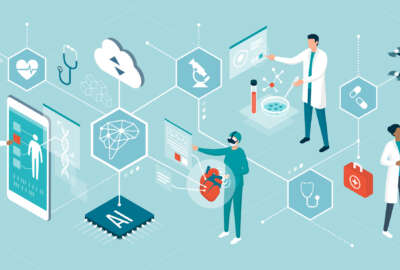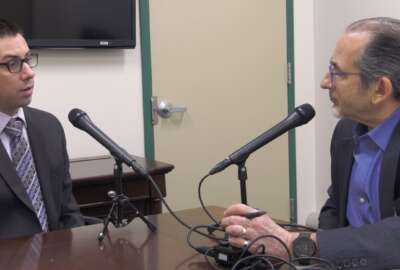The government’s premier tech-transfer group, the Federal Lab Consortium celebrates 50 years in business
It's not an agency, but it works to transfer vital technology developments out of federal laboratories and into the market. The Federal Lab Consortium encompasses...
It’s not an agency, but it works to transfer vital technology developments out of federal laboratories and into the market. The Federal Lab Consortium encompasses some 300 federal organizations. For an update on 50 years, the Federal Drive with Tom Temin spoke with Executive Director Paul Zielinski and the Senior Technology-Transfer Professional from the National Cancer Institute, Whitney Hastings.
Interview Transcript:
Tom Temin And, you know, I didn’t realize that it’s been 50 years of technology transfer. Sometimes we tend to think that all technology was invented last week in Silicon Valley. But in fact, this has been a technologically fertile country for centuries. And maybe just tell us how the consortium. Because everyone’s got a day job. Except Paul. You’re the only full-time person there at their agencies. In your case, Doctor Hastings, the National Cancer Institute. Tell us about the 50th year here.
Whitney Hastings Yeah, well, this is exciting. Five decades of progress carrying out our mission of promoting tech transfer, educating tech transfer professionals, and facilitating the partnerships between the federal labs and companies in bringing technologies to the marketplace. So, it’s exciting. We’re going to celebrate this at our national meeting in April. So that’s super exciting. It’s an annual gathering where we’re going to have hundreds of tech transfer professionals all in one place in Dallas, Texas. This conference is a big event for us, and so we’ve got lots planned to celebrate these 50 years. If you go to our website, you’ll see a timeline. The past five decades of tech transfer. We’ll also have it at our meeting for folks to check out and see all the great things that we’ve done over the past 50 years.
Tom Temin And Paul, of course, the recipient of tech transfer is the marketplace, companies, corporations, and so forth. And would you say that the consortium’s main role is maybe unifying the way agencies do this, so that it looks cogent to the external people that are the recipients of the transfer, that it’s not wildly different from the National Cancer Institute to, you know, some labs somewhere out in, say, the Pacific Northwest National Laboratory.
Paul Zielinski Sure. And that’s exactly the point of the consortium. I mean, when you get down to when we talk about technology transfer, you know, you invest your tax dollars in research and development performed by the government, all the different labs and the agencies, they’re working on their mission. But, you know, our government doesn’t make stuff. You don’t buy something from the government. You buy something from a company. So, for that research to reach you as a person that paid for it, it has to get transferred. So, we transfer it to a company they make sell, distribute that material, something you can buy, service you can use. So, there’s lots of great and exciting examples of tech transfer, but that’s really the heart of it. And like you said, you know, if you’re working with the Environmental Protection Agency or NASA or the NIH or the Department of Defense, you know, as the public you look at, it is the government, and you want a similar experience and sort of like a cohesive experience. And that’s really what we try to do, is form this community around all of the professionals in this field.
Tom Temin And Whitney, give us an example, say, of something that you’ve seen where a federally funded development occurred. What does it take to get it out into the marketplace so that it’s all legal and kosher?
Whitney Hastings It takes a lot of hard work from our tech transfer professionals, and a lot of dedication from the scientists that are at the labs, all the way to the companies. I’ll give you a couple of examples. Technology is transferred from Health and Human Services that many people are aware of. For example, Gardasil, the HPV vaccine that almost all of your kids at age 11 get these days. So that was the result of technology transferred from the federal labs into companies in the marketplace. Another great example for third world countries. For example, …. that was an FDA technology where it involved partnerships as well as licensing to get that. And now I think, there have been millions that have been vaccinated as a result of that great therapy.
Tom Temin And what’s the essential process? What do people that do this for a living? Technology transfer for their agencies. Give us the skeleton view anyway of the steps involved.
Whitney Hastings Yeah, absolutely. So, it all starts with us protecting our intellectual property. And we do that through patenting in most cases. And so, we’ll start there. And usually, the technologies developed in those early years, data scientists at the individual agencies. Then we do a little bit of market outreach, and we try and find a partner, the right partner, to take the technology to the market. Once we find that partner will execute a licensing agreement. We may also do a collaboration so that the scientists can work with the company while they do that early-stage development. And then once that early-stage development is done, we release the reins and let the company take it from there.
Tom Temin We are speaking with. Hastings. She is the chair of the Federal Lab Consortium and with Paul Zielinski, the executive director. And just to be clear, then, this is work that had to be done by government scientists. That is to say, not work done under contract, say, under a crater where the company develops this technology in the first place.
Whitney Hastings Yeah, it usually starts with the federal scientists coming up with the original idea. There are cases where we do have create a partnership, between a company and that federal scientists and new innovations. New intellectual property is developed that might be co-owned, for example. But, yeah, the original nugget or first step is the idea and the innovation from the federal scientists.
Tom Temin And, Paul, what have you noticed over the years in the motivation end of this? I mean, companies want to license technology because they feel they can sell it, make some money. The federal scientists may have developed it out of the goodness of her or his own heart, but yet might feel, oh golly, maybe I should benefit from this a little bit more than just my federal salary. And the button I get, you know, for having transferred something out.
Paul Zielinski I think one of the important things, though, is that actually the work that’s done is very mission oriented at the laboratories. I mean, they’re trying to accomplish what they’re assigned to do when you get these great inventions. Well, you know, you don’t accomplish the mission just by having the idea. You accomplish the mission by putting that into action. That’s where these partnerships come in, and that’s where this transfer comes in, because all of a sudden, this is something that you can do. You can actually if you’re the Department of Defense, you might buy it, but you have to have somebody produce it. So, these things have to exist. That’s the key. So, the scientists, you know, it’s a great idea. We’ll transfer it to somebody they can make and sell that product. That’s the accomplishment of the mission actually. And in fact, yes, there is some level of the royalties that is shared with the inventors. It’s not huge amounts, but it is it, you know, it’s a pretty good incentive, in order to get them to really participate in the process, identify inventions and actually, you know, then help us get into the marketplace.
Tom Temin So the federal scientists can share a little bit in it in what ensues after the transfer.
Paul Zielinski Yeah, there’s a percentage that’s actually in the law that goes to the scientist as the inventor of the for any of the royalties that the government takes it. Now, you have to understand, it’s not huge amounts of royalties that we take in in all cases. In a few cases, when you mentioned, like, for example, vaccine. Yeah, those are some pretty substantial royalties. That’s a lot larger amount of money. But in a lot of cases, it may not be huge amounts of money that comes in, you know, might actually be a relatively small invention or, you know, a small royalty stream. But it’s an important invention, nonetheless. Sure. So, you know, the amount of money transfer. The idea of the license, though, is sort of like a, you know, a deed you can get, the company can gather investment itself.
Tom Temin Sure. Well, as one of my professors used to say, that small royalty might be better than the jab in the eye with a sharp object. So, the right to, you know, on that. And how has this whole process changed over the years? What are some of the big learnings that have come through the FLC in 50 years of doing technology transfer?
Paul Zielinski But when you look at it really, I mean, a lot of this even goes back to, you know, World War Two and before. But, you know, well, you what you get down to is you’ve got this huge capability of research. How do you not just use it to win the war, but win the peace as it was put? So, you know, you’ve got that. And then so you get a group of folks from the Department of Defense that formed this Defense Laboratory consortium. It’s like, hey, we’re all doing the same thing. Can we work together, do the same stuff? So that happened in the early 70s. By the time you get to 1974 our 50-year anniversary, they said, you know what? Let’s let the other federal agencies into this consortium as well. You get the federal laboratory consortium. So, in 1980, you have two huge pieces of legislation. You get a thing called the Stephenson Weidler Act that says, look, Tech transfer is a mission. This is actually part of your mission as a federal agency and as a federal laboratory. So, to establish that you got a thing called the Bayh-Dole Act that works with, okay, let’s recognize that there are intellectual property and that the world deals in intellectual property. So, it established how we work with that. And you fast forward to 1986. Two things happen. We mention crate is very cooperative research and development agreements, public private partnerships. So that’s authorized in 86 as well as actually putting it into law. This thing, the federal laboratory consortium, that was an idea. It was people working together out of the goodness of their heart now was suddenly required in 1986. So that’s some of the huge milestones that had happened in terms of getting to where we are today.
Tom Temin And, Whitney, do you find that the existence of the consortium can also help agencies avoid duplicative types of research? If everyone knows what people are up to?
Whitney Hastings Oh, absolutely. We actually have collaborations amongst the different agencies on a regular basis. At the national meeting, I mentioned the award ceremony that we’ll have or we’re going to talk about the past 50 years. One of our awards that we give is interagency partnership, where we’re partnering together to accomplish something that has a similar mission, or we have a similar goal. So, we’re always trying to work together. I would say one of my favorite things about being part of the FLC is learning from fellow tech transfer managers. I can give you a concrete example where my agency didn’t have as much software. Talk about one of the innovative changes over the past 50 years, how software has really taken off in artificial intelligence. And so, you know, some of the other agencies like the NSA and NASA, they were experts in transferring software out to the marketplace. And so, for us in Health and Human Services, we didn’t deal with it very much. But now, as you notice, there’s tons of software as medical devices. So as a result of that, you know, I learned from my tech transfer colleagues what’s the best practice in transferring that to companies to the public open-source software type technology. So. So yeah, we’re learning from each other all the time.
Tom Temin That’s an important point. Then there’s no real boilerplate process for all of technology transfer software or an artificial intelligence application is one thing. But if you develop a new metal alloy transferring, that’s a whole different process. Or maybe the same process, but a different set of parameters.
Whitney Hastings Yeah. Another example is 3D printing new innovation. Now we can 3D print cells. It’s amazing.
Tom Temin All right. And I guess my final question is well, I’ll make an analogy rulemaking by federal agencies. That’s what hundreds of agencies also do. And the federal rulemaking process, cumbersome as it might seem, is actually a model for many other nations and scientists such as yourself. Dr Hastings do interact with colleagues internationally. What’s the international view of the FLC and define the United States as a model in the technology transfer area as well?
Whitney Hastings I’d say, we’re a pretty good model. We were established early on compared to some of the other countries, and so we’ve had some ambassadors come and visit us here at FLC to learn a little bit more about how we do tech transfer or some of the legislation and legal requirements. We are the Federal Laboratory Consortium for the U.S., and so our labs are comprised of the 300 plus federal laboratories here, and those are our members and constituents that we serve. But we’re always happy to be a role model to others and bring others in. And feel free to learn from what we’ve done in the past.
Tom Temin All right, Paul, any final comments? As the 50th year dawns here.
Paul Zielinski Well, we’re very excited about this last 50 years and very excited about moving forward in the future. As Whitney said, we’ve got a big event coming up with our national meeting, so we’re looking forward to inviting people in. It’s all about the networking and that’s really part of a tech transfer.
Copyright © 2025 Federal News Network. All rights reserved. This website is not intended for users located within the European Economic Area.
Tom Temin is host of the Federal Drive and has been providing insight on federal technology and management issues for more than 30 years.
Follow @tteminWFED






